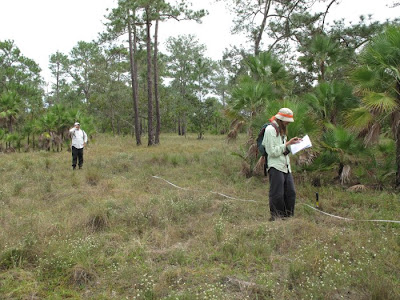
We spent four days out in the savanna doing transects and plots in various vegetation types. I've always thought of savannas as very dry places, but this definitely wasn't the case here.

Waiting for the canoe in the "Swamp of Despair". The first day we got a short canoe shuttle and then walked much of the way through thigh to chest deep water. It was actually pretty fun, or so I thought. Not everyone agreed.

The trail/canoe route.
In past year's students have apparently been able to walk this section without getting their feet wet. Two weeks of hard rain right before we arrived made the lagoon level rise by over a metre.


A bromeliad (pineapple family) growing on a shrub.

Somehow when there are palms on your transect, it doesn't feel like work.

We spent a day doing some forest plots in this pine and oak savanna. It felt a lot like the Okanagan back in BC.

Another bromeliad, this one growing on a caribbean pine.

There was a patch of thick, wet, royal palm forest growing in the middle of the pine savanna, so we did some more plots. It was one of my favourite forests, partly because it was so unexpected.

You don't need long-arm pruners when Frederico is in your group.

Unidentified poop.

Alex, our soil pit digger. We found a metre of peat sitting on top of some black clay in here. The pine forest that was about 300m from here was all coarse sandy soils.
 After two weeks at Hillbank field station we ran out of tropical plants to identify and were forced to go to Caye Caulker, a little island off the coast of Belize, to study some algae for a day.
After two weeks at Hillbank field station we ran out of tropical plants to identify and were forced to go to Caye Caulker, a little island off the coast of Belize, to study some algae for a day.
 If you're going to end up in jail, this is probably a good place to do it.
If you're going to end up in jail, this is probably a good place to do it. We headed out in a boat to go snorkel... I mean, to study some algae up close like the good botanists that we all are.
We headed out in a boat to go snorkel... I mean, to study some algae up close like the good botanists that we all are.

















































